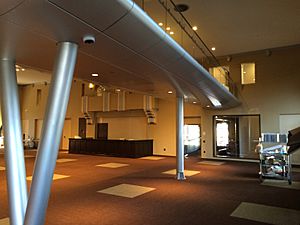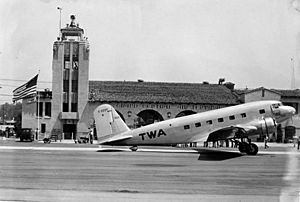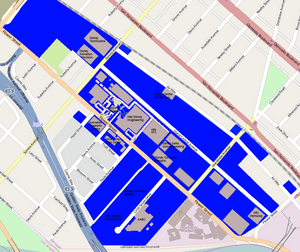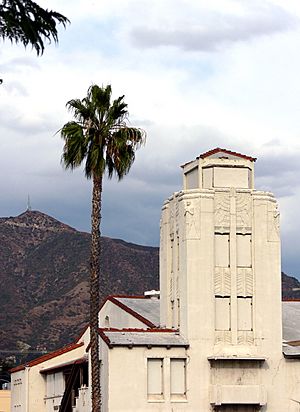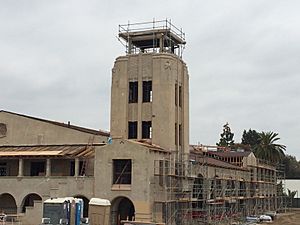Grand Central Airport (California) facts for kids
Grand Central Airport was once a very important airport in Glendale, California. It was also known as Grand Central Air Terminal (GCAT). This airport helped the city of Glendale grow in the 1920s. It was also a big part of how aviation (flying planes) developed in the United States.
The main building, called the terminal, was built in 1928. It is still standing today at 1310 Air Way. Since 1997, The Walt Disney Company has owned it. It is now part of their Grand Central Creative Campus (GC3). Three old airplane hangars are also still there. The place where the main runway used to be is now a public street called Grand Central Avenue. The runway was made of concrete and was about 3,800-foot (1,200 m) long.
Contents
How it Began
The idea for this airport likely came from Leslie Coombs Brand. He was a very important person in the early days of Glendale. In 1904, he built a large house called Brand Castle. It is now the Brand Library.
Mr. Brand saw a grass airstrip across the Los Angeles River. It was built in 1912. So, in 1915, he decided to build his own grass airstrip below his mansion. He built his first hangar in 1916. He even had parties where guests had to fly in with their own planes!
Soon, local business people wanted to build a bigger airport. They wanted it to be used for commercial flights. In 1923, the Glendale Municipal Airport opened. It had a paved runway 3,800 ft (1,200 m) long and 100 ft (30 m) wide. The airport covered about 112-acre (0.45 km2).
Later, other investors bought the airport. They made it bigger, to 175 acres (0.71 km2). They renamed it "Grand Central Air Terminal." On February 22, 1929, a new terminal building with a control tower opened. It was a big celebration!
The terminal was designed by Henry L. Gogerty. He wanted it to look like a grand train station. It mixed Spanish Colonial Revival style with Art Deco designs. GCAT became a main entry point for flights into Los Angeles. It was also the first airport west of the Rocky Mountains to have a paved runway.
Within a year, the airport was sold to the Curtiss-Wright Flying Service. It was run by C. C. Moseley. He later helped start Western Airlines. Grand Central became the biggest employer in Glendale. Moseley also started his first private flying school there. It was called the Curtiss-Wright Technical Institute.
Famous People at GCAT
Many famous aviation pioneers worked at GCAT. They were pilots, designers, mechanics, teachers, and airplane builders. Here are some of them:
- Charles Lindbergh flew the first regular coast-to-coast flight from Grand Central's runway. He organized Transcontinental Air Transport. This company later became Trans-World Airlines.
- Amelia Earhart used the airport often. She even bought her first plane there.
- Laura Ingalls was the first woman to fly solo across the country. She landed in Glendale in 1930.
- Albert Forsythe and Charles Anderson were the first African American pilots to fly across the country. They finished their flight in Glendale in 1933. Their flight helped open doors for the black Tuskegee Airmen in World War II.
- Thomas Benton Slate built a metal dirigible (a type of airship) in 1925. It was 212 ft (65 m) long. He called it "City of Glendale." It briefly flew in 1929 but then crashed.
- Howard Hughes built his very fast H-1 Racer at GCAT in 1935. This was the start of his Hughes Aircraft Company.
- Jack Northrop started his Avion Aviation company at the airport in 1927.
- William Boeing bought Northrop's business. He moved it to Burbank's United Airport. This is now Hollywood Burbank Airport.
- C. C. Moseley also ran a flight academy at GCAT. Pilots and mechanics from his school joined the Eagle Squadron. These volunteers flew against Hitler in the Battle of Britain before America joined World War II.
- Actor Robert Cummings was a pilot and flight instructor who used this airport.
Some airlines that started at GCA include TWA, Varney, Western, and Pickwick Airlines.
Movies and Movie Stars
Grand Central Airport was a popular place for filming movies. Many scenes were shot there, including for:
- Hell's Angels (1930) by Howard Hughes
- Bright Eyes (1934) starring Shirley Temple
- Lady Killer (1933) with James Cagney
- Sky Giant (1938) with Joan Fontaine
- Hats Off (1936) with John Payne
- The musical Hollywood Hotel (1937) with Dick Powell
- The adventure film Secret Service of the Air (1939) starring Ronald Reagan
The airport was also known for stunt flying. People like Paul Mantz supplied planes for the movie industry. Almost every type of airplane from the 1920s, 1930s, and 1940s could be seen at GCAT. They were either there for movies or for service.
During Wartime
When Pearl Harbor was attacked on December 7, 1941, Grand Central Airport closed to private flights. All other West Coast airports did too. The government took over the airport. They camouflaged it (hid it with special paint and nets) and made it an important defense base for Los Angeles.
In 1942, the runway was made longer. It went from 3,800 feet to 5,000 feet. This was to fit larger planes and future jet aircraft.
The airport became a training ground for United States Army Air Forces pilots. They learned to fly planes like the Fairchild PT-19 and PT-17 Stearman. Pilots from the Royal Air Force also trained there.
A training base for P-38 planes was built nearby. It prepared pilots for fighting in Europe. Hundreds of P-51s, C-47s, and B-25s were fixed up at Grand Central Airport. Larger planes like the B-29 were sent to a service center in Arizona.
On April 14, 1944, a fire at the airport destroyed three buildings and seven aircraft. Five workers were hurt.
After the War
In 1947, the runway was made shorter again, back to 3,800 feet. The airport went back to private use. But it stopped making money. So, in 1959, it closed down. The land was then used to build the Grand Central Business Park.
Before it closed, the airport hosted a car race in 1955. About 6,000 people came to watch. After closing, the airport was used as a private heliport for the Los Angeles Police Department's helicopters until 1983.
In 1961, WED Enterprises opened a creative workshop in the business park. This company designs Disney theme parks and attractions.
Grand Central Creative Campus
In 1999, plans were announced to turn the Grand Central Business Park into the Grand Central Creative Campus. More details came out in 2000. The plan was to build many office buildings and sound stages. It would have space for 10,000 employees.
In 2001, The Walt Disney Company planned to expand the campus even more. In 2004, Disney got approval for the first part of this plan. It included two office buildings designed to match the Art Deco style of the nearby KABC-TV studio. A day care center for Disney employees was approved in 2008.
Disney's Pixar sequel unit, Circle 7 Animation, started in a converted warehouse on the campus in 2004. However, it closed in 2006.
The second phase of construction began in 2010. It included a large six-story building and a parking garage. About 1,200 employees were expected to work in the new building. In 2018, the Disney Stores USA headquarters moved to the campus.
Some Disney groups located on the campus are:
- Disney Television Animation
- DisneyToon Studios (closed in 2018)
- Marvel Animation
- The Disney Children's Center, Inc.
- Walt Disney Imagineering (since 1961)
- Disney Store headquarters
- Mickey's of Glendale (an exclusive Imagineering store)
The KABC-TV studios are next to the campus but are not part of it.
National Register Listing
The old terminal building was added to the National Register of Historic Places on March 27, 2017. This means it is recognized as an important historical site.



